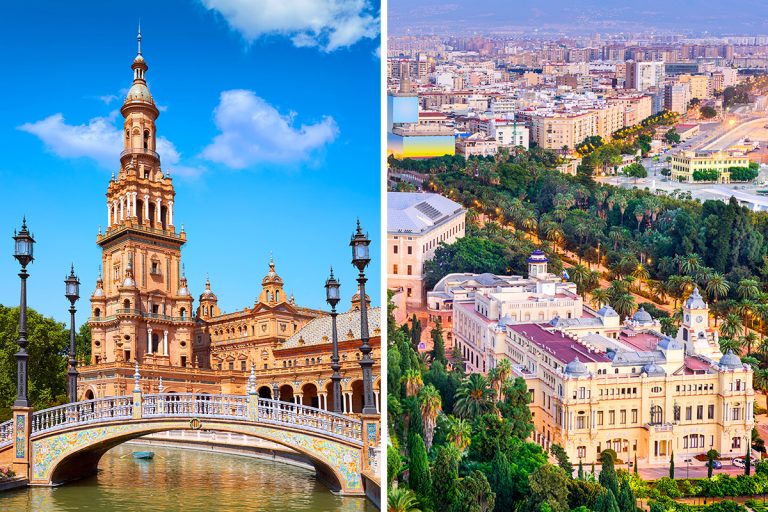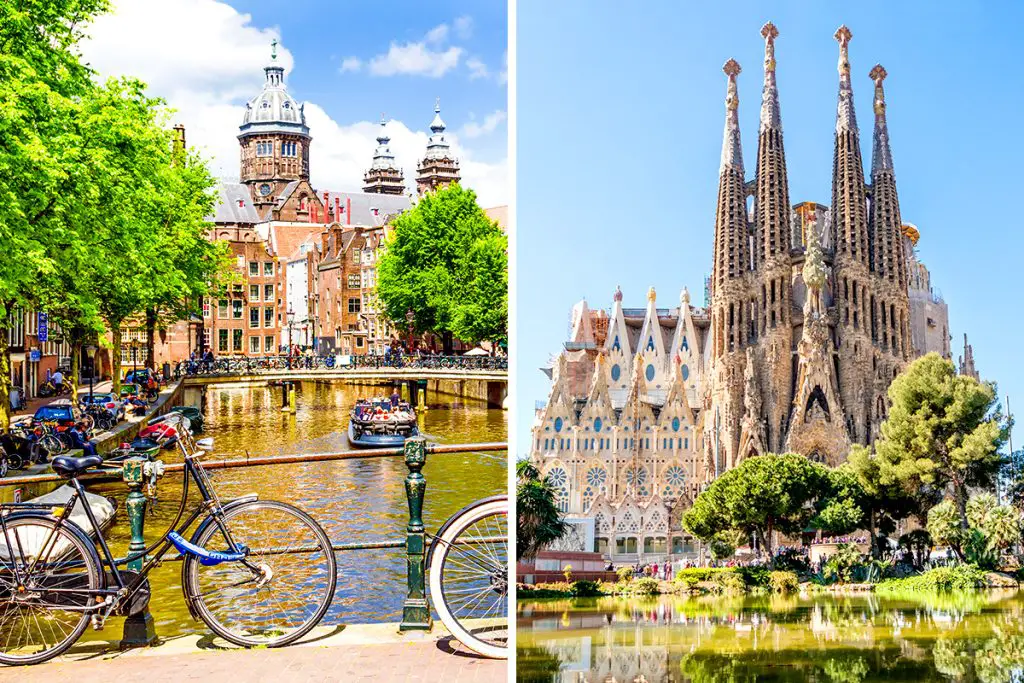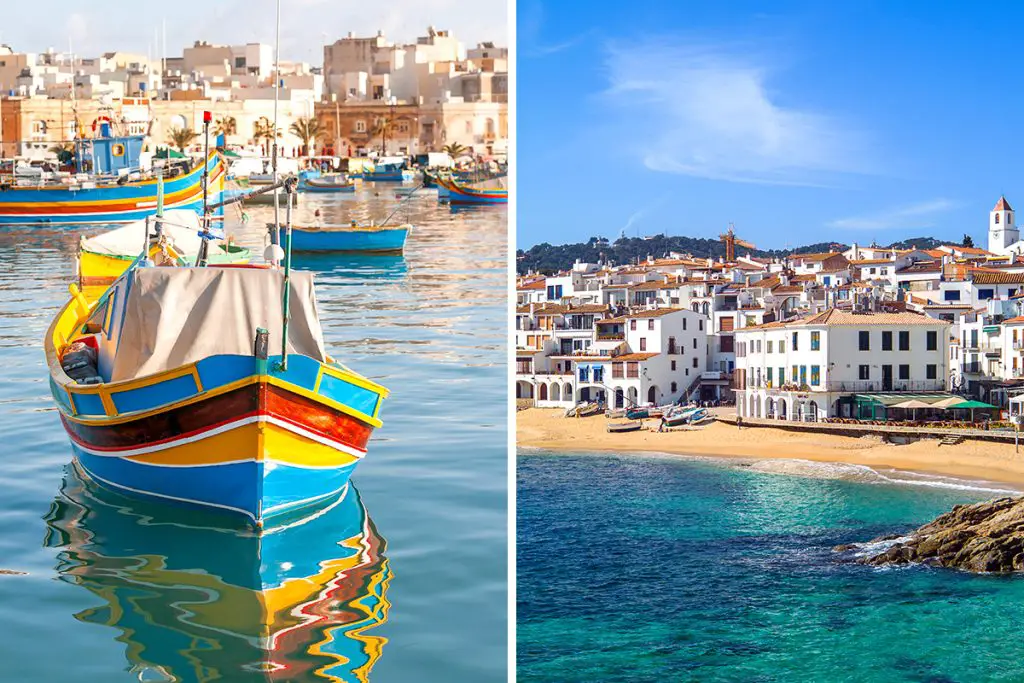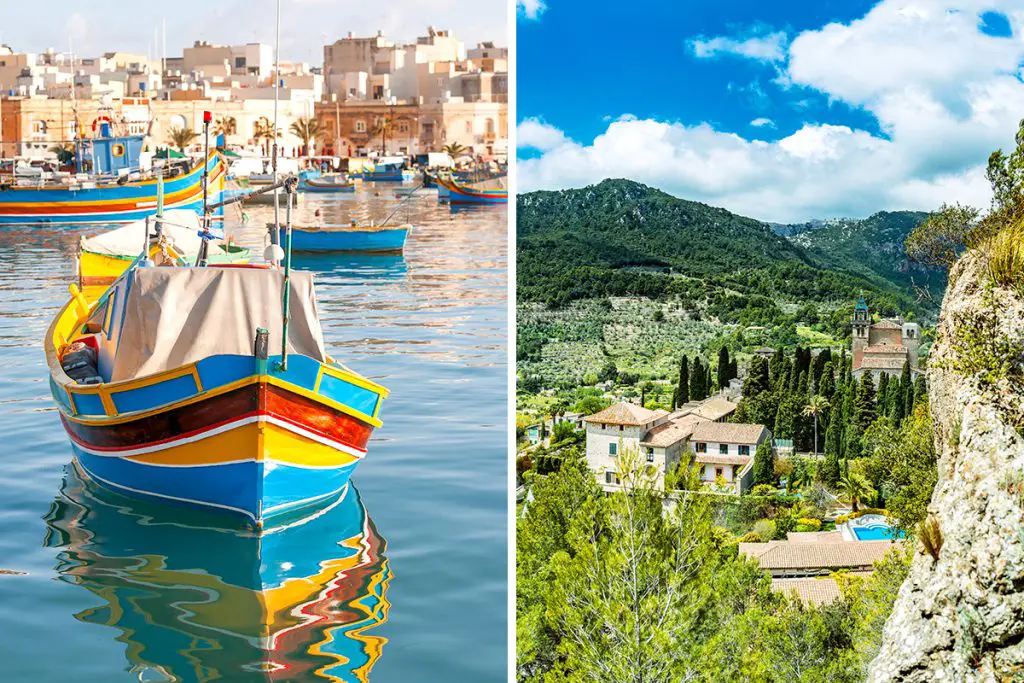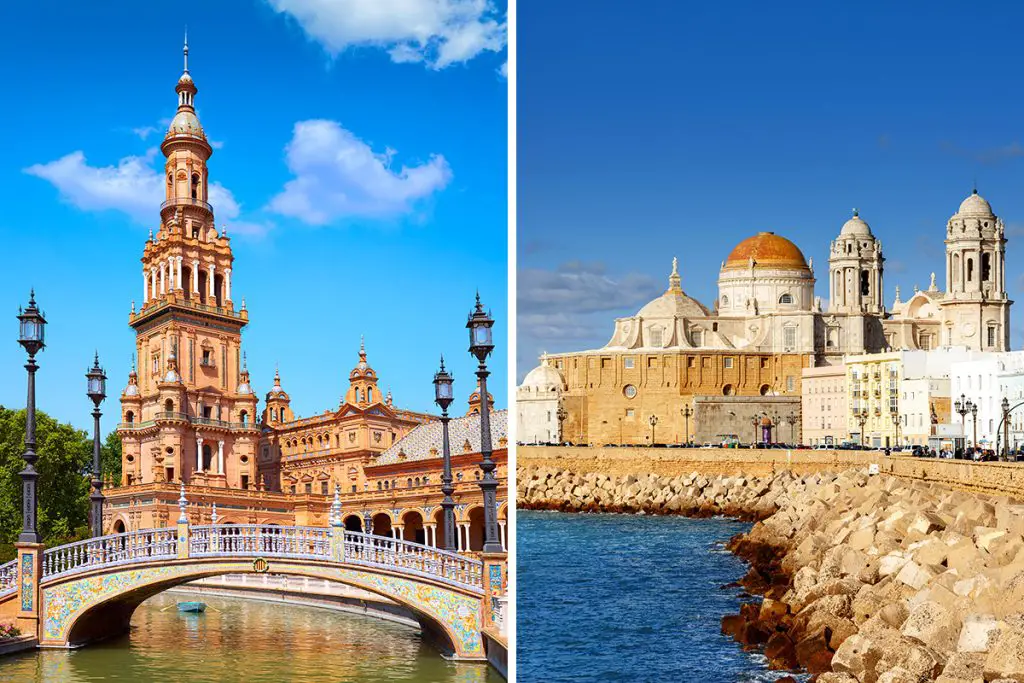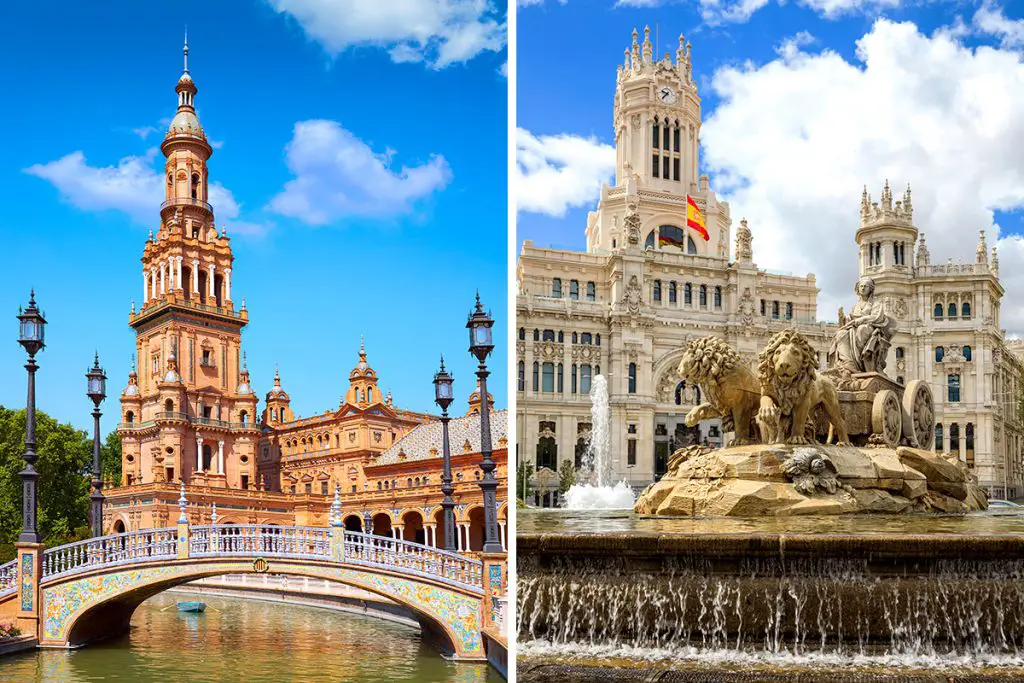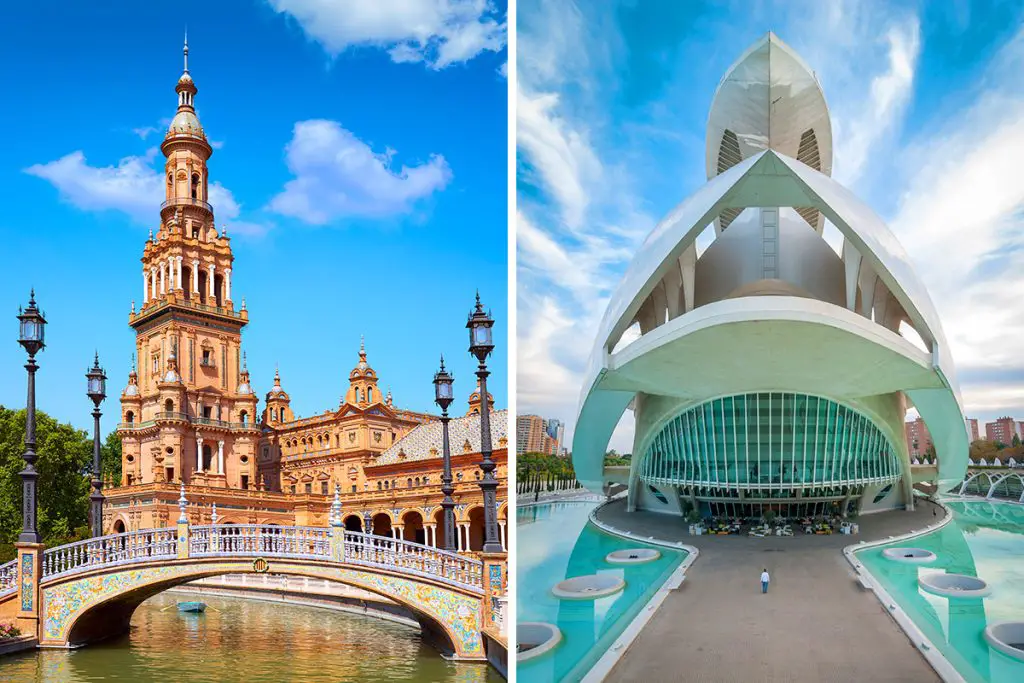Deciding on your next Spanish getaway spot? Both Seville and Malaga have their own magnetic appeal. Your travel style, interests, and what you seek in a vacation could be the deal-breaker here. Ready to dive into the details? Read on to find out which Spanish city is your perfect match.
History & Culture
At the intersection of history and culture, you’ll find that Seville and Malaga offer unique experiences. These cities might both be in southern Spain, but they each tell a different tale. Let’s explore what makes them stand out.
Seville is steeped in a rich history that dates back to Roman times. Its deep roots are evident in everything from its grand palaces to its love for flamenco dance. This city wears its history like a cloak, enveloping you in stories of the past. In Seville, traditions aren’t just something you read about; they’re a part of daily life.
Malaga, on the other hand, takes a more relaxed approach. Sure, it’s ancient, but it’s also a city that loves its contemporary art and youthful spirit. While its history is fascinating, Malaga doesn’t let it dictate its present. You’ll find a blend of the old and new, from historic castles to modern art galleries.
In Seville, you’ll encounter a city deeply connected to its past, where even the streets seem to tell tales of grandeur and ancient civilizations. Malaga seems more focused on the here and now, incorporating its rich history into a lifestyle that values modern comforts and cultural diversity.
But it’s not a case of one being better than the other. Both cities offer a textured experience. In Seville, you’ll feel like a time traveler, while in Malaga, you’ll embrace the blend of different eras coexisting in harmony.
So, if you’re a history buff who loves being swept off your feet by timeless tales and traditions, Seville might be the one for you. But if you value a more contemporary cultural landscape where history meets today’s comforts, Malaga might just steal your heart.
Attractions & Activities
You might think that all the fun stuff to do in a Spanish city will be pretty much the same. But trust us, Seville and Malaga offer two very different playbooks when it comes to attractions and activities. Let’s dive into what makes each city unique in this department.
Seville is a place where architecture and history blend in the most magical way. The city is home to the Alcázar, a royal palace that’s a marvel of Islamic architecture. Then, there’s the Cathedral of Seville, where you can even climb the Giralda Tower for a bird’s-eye view of the city.
If you love walking, the narrow lanes of the Santa Cruz district are like a maze of wonders, full of secrets waiting to be discovered.
Malaga, on the other side, is more than just a pretty face. It’s the birthplace of Picasso, and yes, it has a museum to prove it: The Picasso Museum. Art enthusiasts can also head to the Carmen Thyssen Museum, which hosts an impressive collection of 19th-century Spanish art.
Nature lovers will find solace in the Montes de Malaga Natural Park, just a short drive from the city, offering hiking and stunning vistas.
Seville invites you to embrace its rich heritage. Imagine a slow, soulful flamenco dance in a cozy bar, or perhaps a rowboat ride in Plaza de España. It’s a city that encourages you to become a part of its age-old narrative.
In contrast, Malaga calls for an adventurous spirit. Apart from museums and parks, you can try out the adventurous Caminito del Rey, a cliffside pathway that used to be one of the world’s most dangerous walks. Here, you’ll walk on wooden planks, high above the river, with safety gear, of course!
In a nutshell, Seville caters to those who love to take it slow, absorbing the grandeur around them. Malaga, on the other hand, has a bit of everything—art, nature, and a dash of adventure. Both cities offer incredible experiences, but your personal preferences will dictate where you’d be happiest.
Beaches
If you’re daydreaming about sun, sand, and sea, both Seville and Malaga have something to offer. Yet, the beach scenes in these two cities are as different as night and day. Let’s figure out which one fits your idea of a perfect beach day.
Seville doesn’t have a coastline, but it isn’t too far from some gorgeous beaches. The closest one, Matalascañas, is about 1 hour and 30 minutes away by car, approximately 78 miles (around 125 kilometers). It’s a spacious stretch, perfect for laying out a towel and catching some rays.
Malaga, being a coastal city, brings the beach right to your doorstep. La Malagueta is the city’s main beach, just a short walk from the city center. Here, you can enjoy the Mediterranean sea and the Spanish sun without the need for a long drive. It’s ideal for quick beach trips to recharge your batteries.
For Seville, think of the beach as a day trip. You’ll need to pack a bag, make plans, and dedicate a whole day to enjoy it. It’s more of a special event.
In Malaga, the beach is a part of daily life. A casual stroll from your hotel can land you right on the sandy shores. No need for a day’s commitment, it’s right there for you whenever you want.
So, what’s the verdict? If you love the idea of a beach being a daily part of your holiday, Malaga is your go-to. But if you’re okay with making a day trip for a beach outing and focusing more on other aspects of your vacation, Seville will still serve you well.
Eating, Drinking & Nightlife
If a city’s soul can be felt through its food, drinks, and nightlife, then Seville and Malaga have souls that are both vibrant but differently seasoned. Let’s pull up a chair and dig into what your culinary and night-out experience would be like in these captivating Spanish cities.
Seville is a haven for those who relish traditional Spanish cuisine. Think tapas bars where each dish is a flavor-packed experience, from “patatas bravas” to “jamon serrano.” You’ll find that the city’s historical areas like Triana and La Macarena have a high density of such tapas bars, making for a culinary journey through time.
Switch gears to Malaga, and you’ll feel the city’s seaside influence on your plate. Seafood is king here. A visit to the local “chiringuitos” is a must, where you can indulge in “espeto,” skewered sardines roasted on an open fire. The Atarazanas Market is another foodie spot, offering an array of local produce and freshly caught fish.
When it comes to drinking, Seville boasts a variety of wines, the most famous being sherry from nearby Jerez. The city’s old taverns are the best spots to sample this fortified wine, where you’ll often find the walls lined with vintage bullfighting posters.
In Malaga, sweet wine made from muscatel grapes is the local favorite. Rooftop bars are aplenty, providing a modern twist to your sipping experience, complete with panoramic views of the city.
Nightlife in Seville is often an extension of dinner. Locals and tourists alike move from tapas bars to flamenco shows or intimate “tablaos” where the dance and music continue into the early morning. Malaga offers a younger vibe with its beach clubs and indie music spots, making the city come alive after the sun sets.
To sum it up, if you’re looking for a more traditional and romantic evening, Seville has got your back. But if you prefer a more eclectic and high-energy night out, Malaga might just be your scene.
Shopping
Whether you’re on the hunt for unique souvenirs or designer labels, shopping in Seville and Malaga offers two different retail experiences. Let’s start filling your shopping bags with details.
Seville is the place for traditional Spanish crafts. You’ll find beautifully embroidered shawls, hand-painted ceramics, and artisanal leather goods in stores around the Cathedral and Barrio Santa Cruz. There’s also a surge of boutiques featuring local designers, adding a contemporary spin to the city’s traditional crafts.
Malaga, in contrast, is a more cosmopolitan shopper’s paradise. The city features Calle Larios, one of the busiest shopping streets in Spain, lined with international brands and high-end Spanish labels. But it doesn’t stop there; Malaga also offers El Corte Inglés, Spain’s largest department store, where you can find everything from clothes to gadgets.
Both cities also have their share of open-air markets. Seville’s Feria Market is a must-visit for antique lovers, while Malaga’s Sunday markets offer handmade crafts and vintage items, making for perfect keepsakes.
Seville is your go-to for a shopping experience that’s deeply connected to Spanish culture and craftsmanship. Malaga, on the other hand, offers a more modern and diverse range of options, where global meets local.
So, whatever your shopping style is—traditional, contemporary, or a mix of both—Seville and Malaga have something special to offer in their unique ways.
Accommodation
Choosing a place to lay your head between days packed with adventure can be a pivotal part of your travel experience. Let’s delve into what you can expect in terms of accommodation when staying in Seville versus Malaga.
Seville is an architecture lover’s dream, and this extends to its hotels and hostels. Many accommodations here are housed in historic buildings, offering you an old-world charm, complete with interior patios and decorative tiles.
Places like the Alfonso XIII or the Hotel Palacio de Villapanés give you a taste of Spanish royalty, while boutique options add a modern twist to the city’s historic soul.
Malaga, being a beach destination, offers a different vibe. There are numerous sea-facing hotels, where you wake up to the calming sounds of waves. If you prefer a high-rise with panoramic views of the coast, Malaga has those too, offering rooftop pools and terraces that are simply Instagrammable.
Budget-conscious? Both cities have their fair share of hostels and Airbnb options. Seville’s hostels often come with their own intimate flamenco shows, while Malaga’s are more likely to organize beach bonfires or city tours.
Price-wise, Malaga generally has a slight edge. Being a larger city with more options, you’re likely to find something that fits your budget a bit easier than in Seville, especially during peak tourist season.
In summary, if you’re after an authentic Spanish setting, Seville’s accommodations are like stepping back in time. Malaga, on the other hand, offers a range of modern comforts, many with stunning sea views. Both have budget-friendly options, but Malaga nudges ahead for those watching their pennies.
Family-Friendliness & Children’s Activities
When traveling with little ones, your destination’s family-friendliness can make or break your trip. So how do Seville and Malaga fare in keeping kids both safe and entertained?
Seville is a city steeped in culture, and this can be educational for children. While some museums might be a snooze-fest for the young ones, the city offers interactive activities like treasure hunts through the historic district or family-friendly bike tours.
Malaga offers its own set of charms for families, mostly through its natural resources. Think sea caves to explore, dolphin watching, and various water sports tailored for children. There’s also a fun science museum and a car museum that little ones tend to love.
Both cities have spacious parks perfect for picnics and letting the kids run free. Maria Luisa Park in Seville has playgrounds and even rowboats, while Malaga’s La Concepción garden offers a botanical education with its exotic plant life.
Safety is comparable in both cities, with well-patrolled tourist areas and child-friendly amenities like high chairs in most restaurants and baby-changing facilities in large public areas.
To sum up, both Seville and Malaga offer engaging and safe environments for families. Seville might captivate the imaginations of older kids with its history and legends, while Malaga keeps things exciting with nature-based activities.
Getting There & Getting Around
Getting to and navigating through your chosen destination can be as important as the destination itself. So, how do Seville and Malaga compare when it comes to accessibility and mobility?
Seville’s San Pablo Airport is about 10 kilometers (around 6.2 miles) from the city center. Direct flights from major European cities make it quite accessible. Malaga’s airport, Pablo Ruiz Picasso, is even closer to its city center—just 8 kilometers (approximately 5 miles) away—and offers a broader range of international flights.
Getting around in Seville is primarily through buses and trams. The city does offer a metro service, but it’s limited to certain areas. Taxis are readily available but can rack up the costs quickly.
In Malaga, the city’s compact nature makes walking a viable option. But if you’re in a hurry, buses and a more extensive metro system are available. Taxis are generally cheaper in Malaga compared to Seville, giving you more flexibility in how you choose to get around.
Both cities offer bike rentals and tour buses as additional options for exploring. Seville has a strong bike lane network, while Malaga’s flatter terrain makes cycling a breeze for families or those not used to hilly areas.
To wrap up, Malaga is slightly more accessible both in terms of getting there and getting around, owing to its larger airport and more extensive public transit. Seville isn’t far behind though, especially if you prefer a destination with a more compact city layout and don’t mind taking taxis or cycling.
Weather
Ah, the weather! It’s often a deciding factor when picking a travel destination. Both Seville and Malaga offer sunny Spanish climates, but there are differences worth noting.
Seville has a hot-summer Mediterranean climate. The city is known for its sizzling temperatures, especially in July and August. The thermometer often shows highs above 95°F (35°C). But it cools down considerably from late September, offering milder, more pleasant weather through spring.
Malaga, being on the coast, experiences a subtropical-Mediterranean climate. It’s generally less extreme than Seville, with summer highs rarely crossing 86°F (30°C). Plus, the sea breeze can make it feel even cooler. Winters are mild, usually hovering around 60°F (15°C).
Both cities boast a fair amount of sunny days throughout the year, yet Malaga offers more opportunities for those looking to escape harsh winter climates, with its slightly warmer winters.
Also, if you’re a rain-averse traveler, Seville is drier. Malaga gets more rainfall, mostly during the winter months, but even then, it’s not excessive.
In summary, if you can handle the heat and prefer a drier climate, Seville is your city. But if you want a milder, sea-influenced climate, Malaga should be on your radar.
Safety
When it comes to travel, feeling safe and secure is paramount. So how do Seville and Malaga compare in the safety department?
Both Seville and Malaga are generally safe cities, especially in well-traveled and touristy areas. Petty crimes like pickpocketing can occur, but they’re not rampant. Simple precautions like keeping an eye on your belongings should suffice.
Seville has a lower crime rate compared to Malaga, particularly regarding property crimes. However, Malaga sees more tourists annually, which could explain the higher incidence.
In non-crime related safety topics, both cities are well-equipped with hospitals and medical facilities. They also have well-illuminated streets, making nighttime navigation less worrisome.
In summary, both Seville and Malaga offer a high level of safety, with a slight edge going to Seville in terms of crime statistics. But in either city, basic vigilance is generally all you’ll need to keep safe.
Cost
Budget often dictates the where and how of travel. So, let’s break down the cost of vacationing in Seville versus Malaga.
In Seville, dining at a mid-range restaurant could set you back around €40 (approximately 45 USD). Accommodations in a 3-star hotel average about 136-151 USD per night. Public transportation via bus costs around €1.40 (about 1.60 USD) for a single ticket.
Malaga tends to be cheaper in most categories. Expect to pay about €50 (roughly 55 USD) for a meal at a similar restaurant. Accommodation costs average around 184 USD, and you have more budget options near the beach! A bus ticket here costs approximately €1.30 (1.50 USD).
While both cities offer free and low-cost attractions, guided tours in Malaga generally cost less, possibly because the city sees a higher volume of tourists.
To sum it up, Seville generally provides more bang for your buck, especially in dining and activities. Malaga, while slightly pricier, offers its own unique experiences that might justify the extra expenditure for some travelers.
Which Is Better – Seville or Malaga?
Choosing between Seville and Malaga for your Spanish escapade is no small task. Both cities offer rich experiences, yet each has its own unique flavor. So, how do you decide? Let’s recap what we’ve uncovered about each destination.
When it comes to history and culture, Seville takes the lead. The city is a haven for those passionate about architecture, flamenco, and old-world charm. Malaga, while historically rich, tends to be more modern and focused on art, thanks to its museums and galleries. If culture and history are top priorities, Seville might be the better fit.
For attractions and activities, both cities offer a wide range of options. Seville is better if you’re into architecture and traditional Spanish festivals. Malaga, on the other hand, has a wider range of outdoor activities thanks to its seaside location. If you’re an outdoorsy person, Malaga could be your playground.
If beaches are your thing, Malaga wins hands down. The city offers a mix of sandy stretches and rocky coves, all accompanied by a sea breeze. Seville, being inland, lacks this natural asset.
For foodies and night owls, both cities have a vibrant food scene and bustling nightlife. However, Malaga has the advantage when it comes to variety, with its unique blend of seafood and traditional Spanish cuisine. The city also has a livelier nightlife scene with more diverse options.
If you’re in the mood for some retail therapy, both cities offer excellent shopping options. However, Malaga takes the edge here as well, with its array of shopping centers and local markets. Seville focuses more on traditional Spanish goods.
When it comes to accommodation, both cities have a range of options to fit various budgets. However, Malaga offers more budget-friendly options near the beach, giving you great views without breaking the bank. Malaga tends to be slightly more expensive but watch out for the experiences though.
Seville is your go-to destination if you’re a culture vulture or history buff. It’s also the better option if you’re looking for a drier climate and are willing to spend a bit more for a unique experience. Malaga, on the other hand, is ideal for beach bums and those looking for a vibrant nightlife and dining scene. It also offers a bit more value for your money. Ultimately, the best choice depends on what experiences you value most in a vacation.

